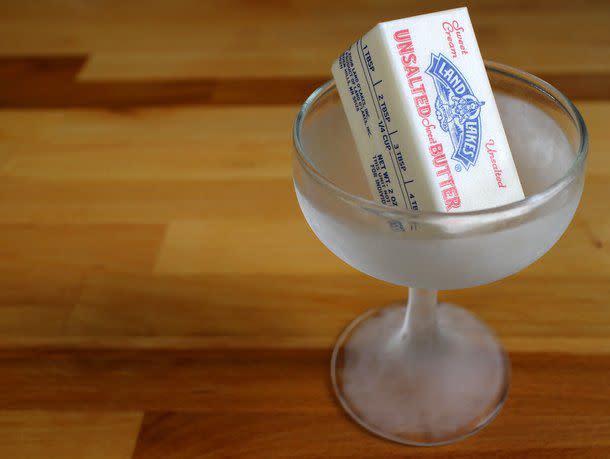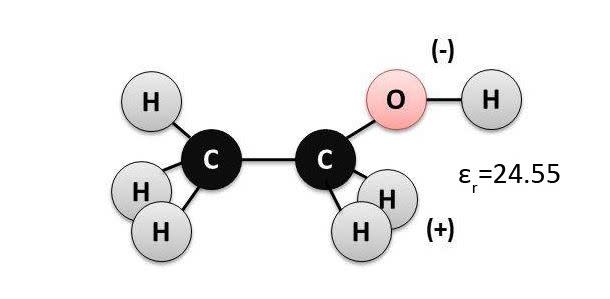The Science of Fat-Washing Cocktails
This clever cocktail technique is an effective way to add savory flavor to spirits.

Serious Eats / Kevin Liu
Fat-washing: It might sound like a process for getting rid of bacon grease on your shirt, but it's actually a clever cocktail technique that adds savory flavor to spirits. To fat-wash your alcohol, you just add a liquid like sesame oil or melted butter to a spirit at room temperature. Let it sit for a few hours, then chill everything in the fridge or freezer until the fat solidifies and can easily be skimmed off. The spirit retains the flavors of the fat even after you've done the skimming.
We've seen fat-washed spirits at bars around the country: we've tried sesame oil-infused gin and a tasty Sazerac infused with duck fat, to name a few. Since the technique gained popularity around 2007, bartenders have experimented with fat-washing spirits with everything from peanut butter to an entire grilled cheese sandwich.
Today, we'll take a look at where fat-washing came from and the science of what's actually going on with this tasty trick.
First, a Little Fat-Washing History
The history of the fat-washed cocktail reads like a who's who in top-tier cocktail making. You might have heard of Benton's Old-Fashioned, a bacon-infused cocktail created by Don Lee at New York's Please Don't Tell (PDT). By combining bourbon and bacon, Lee brought together two of America's favorite flavors in a classy, drinkable format. The drink took fat-washing from mad-scientist status to must-try at home practically overnight.
Lee credits his knowledge of fat-washing to another well-known New York City bartender: Eben Freeman, then working at the wildly innovative WD-50. Freeman's probably best known for brown-butter-washed rum. And, he in turn credits his innovations to chef Sam Mason, who at the time was working as the pastry chef at WD-50.
If we peel back the onion even further, bartender/writer/thought leader Gaz Regan explains in his Annual Manual for Bartenders 2011 that Mason was himself inspired by the techniques of perfumers, who have long used fat-washing to extract aromas from tricky compounds.
The Science of Fat-Washing
I started researching this topic because Serious Eats reader QuinnO sent this question to the SE team:
"I was wondering what actually happens you fat wash spirits. Is it the same as a regular old infusion? Instructions always claim that once you chill, skim, and strain, you aren't left with any fat in the mix, but does some of it dissolve into the alcohol? It definitely feels like the texture changes."
There aren't a whole lot of scientific papers that research the fat-washing of cocktails. So, I took a page from Sam Mason and considered the techniques of perfumers.
Let's say you wanted to extract the flavors from an orange peel. As you may know, orange peels are lined with sacs filled with aromatic oils. That's why you can flame an orange twist—the oils from the peel are flammable.
But perfumers don't only use oils for their aromas. While many powerful aromatic compounds are fat-soluble, others are water-soluble. Consider the extremely aromatic orange flower water, for example. Orange flower water is an example of a hydrosol—the water-soluble aromatic compounds left over after oil-soluble aromas have been removed.
Add alcohol to the mix and things start to get interesting.
Alcohol (or ethanol/ethyl alcohol) can dissolve both oil-soluble and water-soluble flavors. That's because the alcohol molecule has two distinct ends, one of which is polar (water-loving) and the other of which is non-polar (oil-loving).

Serious Eats / Kevin Liu
In the above illustration, the polar side is to the right of the image and the non-polar side is to the left. Whereas water is considered a powerful polar solvent, with a dielectric constant (εr) of 80, alcohol is a less powerful, but still effective polar solvent, clocking in at a respectable εr of 24.55. Any molecule with εr greater than 15 can act as a polar solvent. The non-polar side of alcohol has no εr and acts instead as a non-polar solvent, which gives it the ability to latch on to oil-soluble flavor compounds.
What does all this mean for fat-washing?
The original question asked whether fat-washing is different from traditional infusions. And the answer is: not really. Regardless of whether you use vanilla beans or sesame oil as the flavor-adding ingredient, alcohol will extract a portion of both the fat-soluble and water-soluble flavors in that ingredient. If you used a pure oil, like olive oil, the majority of the flavor compounds would be fat-soluble ones. If you used butter—which is not actually a pure fat, but rather an emulsion of water and oil—you would capture both oil-soluble and water-soluble flavor compounds.
How does fat-washing change the texture of a spirit?
Many sources say that by freezing a fat-washed spirit, it's possible to strip out 100% of the original fat. Frankly, that's probably not true. Freezing the spirit solidifies the fat and makes it easier to strain, but it's very unlikely you'd be able to strain out every bit of the fat. There probably wouldn't be enough fat left to affect calorie counts, but even a small amount of dissolved oils could affect mouthfeel.
April 2014
Read More
Read the original article on Serious Eats.